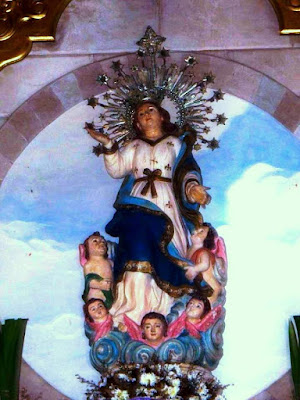Nuestra Señora de la Asuncion de Tanauan - Protectress of Tanauan, Leyte
 |
| Nuestra Señora de la Asuncion de Tanauan |
The image
The miraculous image of Nuestra Señora de la Asuncion de Tanauan is a carved image of the Blessed Virgin Mary on the moment of her glorious Assumption to heaven both body and soul.
She is depicted with her right arm raises from the heaven and her head looking upward decorated with the diagnostic doce estrellas, her dress with star motif and a belt, being blown up as if the wind is blowing. The Virgin is also depicted standing on the clouds and with angels assisting her on her Assumption.
The origin
 |
| Nuestra Señora de la Asuncion de Tanauan |
The present image enthroned in the altar mayor of the church is the original image of La Asuncion de Nuestra Señora of Tanauan which is said to be one of the oldest existing images in Leyte. According to some scholars, the image can be traced during the time of the Jesuits in the 1700’s. Many miracles and provenances are attributed to the image as she has been invoked for many centuries as town’s protectress from various calamities and pestilences that struck the town.
The Cofradia de la Asuncion de Nuestra Señora de Tanauan began only in the year 1909 with Doña Obdulla de Veyra Perez serving as its first Hermana Mayor. The celebration of the yearly fiesta remained unbroken even during the brink of the Second World War.
 |
| Our Lady of the Assumption Parish, Tanauan, Leyte |
From a provisional chapel that served as the first house of worship, the people of Tanauan felt an urgency to build a spacious church and fortified with stone walls as a defense and protection against the marauding Moro pirates. This construction plan became the earliest fortified church complex in the island of Leyte.
A certain Juanillo Siengco who was a Mestizo de Sangley (Chinese Immigrant) arrived in the town of Tanauan sometime in 1661. He was familiar with building stone houses in Luzon and was employed to instruct and oversee the building of the church and convent surrounded by stone wall. The work was completed in the year 1714. Much renovation was done during the time of the Franciscan administration and in 1897, the church was partly destroyed during a strong typhoon and it was later repaired when the secular clergy began to take the helm. The Church survived a hurricane and storm surge of 1897. The Church takes pride of its Stations of the Cross made of Spanish terracotta originally made in Mexico.
 |
| Pasaka Festival |
The devotion to Nuestra Señora de la Asuncion of Tanauan continues to be strong and remained vital to the lives of the people of Tanauan, Leyte. The feast of the Assumption, which is set every August 15 and it marked the annual Pasaka Festival. The Pasaka Festival started in 1991. The word "pasaka" means "assumption" which refers to the Virgin Mary as she was assumed into heaven.
The festival, which runs from August 1 through 15, is seen as an opportunity to showcase the rich cultural heritage of Tanauan. It is a means of paying homage and thanksgiving to the town’s Patroness, Our Lady of the Assumption. It begins with a nightly cultural presentation being held from August 1 through 14 at the Tanauan Public Plaza, which showcases the best talents, culture, and tradition of the municipality participated in by various schools, the local government unit, and the non-government organizations of Tanauan. In the afternoon of August 14, the traditional Pasaka Festival Competition is held which features a colorful presentation of dance drama and street-dancing that depicts a community paying homage to the Blessed Virgin as she is assumed into heaven.
The festival culminates on August 15, the Feast of the town’s Patroness, Our Lady of the Assumption, and a Holy Mass is celebrated at the Our Lady of the Assumption Parish Church. It is also observed as Tanauan Day which is a local holiday.
References:
Artigas y Cuerva, Manuel. Reseña de la Provincia de Leyte: EstudioHistóricoBio-bibliográfico. Manila: ImprentaCultura Filipina. 1914.
Cruikshank, Bruce. Secular Clergy in the Philippines, 1565-1898 published in Academia, May 2015.
De Castro, Fray Agustin Ma. Relacion Veridica del Estado que tenian los Pueblos de la Isla de Leyte cuando los recibio esta Provincia de mano de los Padres Jesuitas el año de 1768, pormandato del Señor Vice-Patron, Gobernador y Capitan General Don Jose Raon published in Osario Venerable (1740-1801).
Huerta, Felix de la, Estado geográfico, topográfico, estadístico, histórico-religioso de la santa y apostólica Provincia de San Gregorio Magno de Filipinas, 1855 & 1865 editions.
Jose, Regalado Trota. Curas de Almas (Preliminary Listing of Parishes and Parish Priests in the 19th Century Philippines Based on the “Guiuas de Forasteros”, 1834-1898) in four volumes, UST Publishing Houses, 2008.
Justimbaste, Emil. A Roots of Our Faith (published in Academia.edu).
Martin y Morales, Ensayo de unasintesis de los trabajos realizados por las corporaciones religiosas españolas de Filipinas, 1901.
Merino, Manuel. Misioneros Agustinos en el Extremo Oriente. Consejo Superior de Investigaciones Científicas, Instituto Santo Toribio de Mogrovejo. Madrid. 1954.
"Pasaka Festival 2007 Showcases Tanauan's Culture and Heritage". Philippine Travel Blog, 2007.
Perez, Fray Elviro J. Catálogo Bio-bibliográfico de los Religiosos Agustinos de la Provincia del Santísimo Nombre de Jesús de las Islas Filipinas. Establecimiento Tipografico Colegio de Santo Tomas. Manila. 1901.
Redondo y Sendino, Felipe. Breve Reseña de lo Que Fue y de lo que es la Diócesis de Cebú en las Islas Filipinas. Establecimiento Tipográfico del Colegio de Sto. Tomás, Manila, 1886.
Tantuico Jr., Francisco S., Leyte: The Historic Islands, 1964.
Tantuico Jr., Francisco S., Leyte Towns Histories/Legends, 1980.
Special thanks to Mr. Manuelito Uy for the documents and photogrpahs of the Virgin of the Assumption of Tanauan, Leyte
+AM+DG+





Comments
Post a Comment